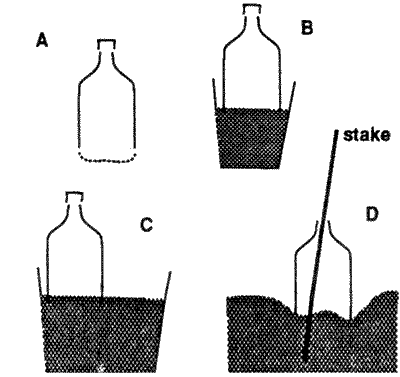
THANK YOU MR COLA
 The clear plastic containers in which cool drinks are now commonly sold can be very useful in raising plants.
The clear plastic containers in which cool drinks are now commonly sold can be very useful in raising plants.
Usually these are 2-litre capacity, though 1.5 to 3-litre sizes also exist. They have a screw cap of metal or plastic. Just cut the bottom off with a sharp knife, where it starts to curve in (A in the drawing), and you have a handy, versatile miniature greenhouse.
The 2-litre size fits well into a standard five-inch plant pot (B). The setup can be used for promoting growth of plants, for germinating seeds, or for getting good strikes of cuttings.
With seeds or small plants, I usually loosen the cap but leave it in place. As plants reach the top, you can remove the cap and let the plant grow through the neck. As the plant gets even bigger, you can lift up the container and pull it over the top of the plant without damage, as long as the top branches are still flexible.
Watering? It's a cinch - you don't need to do anything special. As long as the container isn't too far into the soil, rain or irrigation running down the side of the pot will be fine to water the plants inside, and no danger of splash damage either. Fine seeds on the soil surface inside are unaffected by wind, rain, or falling leaves, and yet get plenty of light.
Pest problems are diminished; with the cap on, there is no way for snails, butterflies, or slaters to get at the plants inside.
The technique is very good with cuttings, especially green or leafy cuttings where the humidity must be kept up. If you want to convince yourself of its benefits, try cuttings partly inside the container and partly outside, in a wider pot (C). Some lavender cuttings were tried like this: almost all those inside took and grew well, all of those outside died.
Trees grown from seed sown in-situ, at the final growing position, almost always are stronger and more stable than ones which are transplanted and have the shock to overcome. But in-situ trees have to be able to survive attack by pests such as rabbits and competition from blown-in weeds. By sowing seeds in the field, at the bottom of a small basin formed so that rainfall will reach the seeds, many of the problems may be avoided by using one of these containers held in position by a stake through the neck (D).
DATE: January 1995
* * * * * * * * * * * * *
